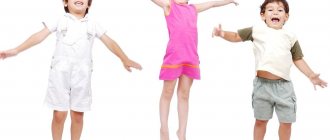There are these golden words: “If your child decides to talk to you and share his problems, drop everything and listen carefully. There's nothing more important than that."
Are you raising a 9 year old child? Then this advice will be especially valuable for you. A difficult transitional age will begin very soon, and now we need to properly prepare for it. Recommendations from psychologists, pediatricians and other specialists will help you organize comfortable conditions for the development of your baby and maintain a warm relationship with him.
Content:
- Age-related features at 9-10 years old Developmental features in girls
- Features of development in boys
- Inconvenient questions
We are looking for the reason!
A nine-year-old child behaves badly and does not obey. The easiest way is to scold, punish, get angry and offended. It’s more difficult to take an adult position, think and try to find a reason. But you need to do exactly this, otherwise the problem may worsen, go deeper and manifest itself later with worse consequences.
It is not always possible to do this on your own. This means you should contact a specialist. We found the reason - we are thinking what to do about it. And most importantly, we continue to love our child, take care of him, trust him...
Prepared by Natalya Kharpaleva
Age characteristics at 9-10 years old
General age-related characteristics in children at this age:
- The functioning of the endocrine system is improved, the sensitivity of the glands to pituitary hormones increases. The body is preparing for puberty.
- The formation of posture continues. Parents need to control how the child walks and sits.
- Muscles have high plasticity.
- Replacement of baby teeth continues.
- The functioning of the brain and visual analyzer is improved. Attention to the details of objects increases: drawings become more detailed.
Features of development in girls
WHO data on the height and weight of girls at 9 years old:
| ⠀ | Very low | Short | Below the average | Average | Above average | High | Very tall |
| Height (cm) | 114,2 | 120,3 | 126,4 | 132,5 | 138,6 | 144,7 | 150,8 |
| Weight, kg) | 18,1 | 20,8 | 24,0 | 28,2 | 33,6 | 41,0 | 51,1 |
⠀ During this period, girls become taller than boys. The fat layer on the abdomen and buttocks increases, which is why the figure is rounded according to the female type.
Parents of girls should pay attention to darkening of pubic and armpit hair and enlarged mammary glands. If such signs of puberty have already appeared, it is worth preparing the child for the onset of menstruation.
Talk about what menstruation is, that it is normal, and teach how to use sanitary pads. Remind them how important it is to maintain personal hygiene.
Features of development in boys
WHO data on the height and weight of boys at 9 years old:
| ⠀ | Very low | Short | Below the average | Average | Above average | High | Very tall |
| Height (cm) | 114,5 | 120,5 | 126,6 | 132,6 | 138,6 | 144,6 | 150,6 |
| Weight, kg) | 18,8 | 21,3 | 24,3 | 28,1 | 33,0 | 39,4 | 48,2 |
⠀ ⠀ Tangible growth spurts are rare, but the foot increases quickly. Parents will notice this by frequently changing shoe sizes.
Boys begin puberty later than girls. If before the age of nine the genital organs have noticeably enlarged, wet dreams and hair growth on the face and pubic area have begun, this may indicate a hormonal imbalance.
Separation periods
The process of separating from the family in which one grew up is not an easy path. It will take a lot of patience, attention, and mental strength in order to achieve understanding with loved ones. At the same time, you must learn to defend your individual boundaries. The stages of separation from parents occur one after another
It is only important in these moments to show patience and tact, so as not to inadvertently offend dear and close people. What are these stages? What do they mean?
1. A feeling of deep internal dissatisfaction. A young man or girl begins to feel that they are not satisfied with their relationship with their parents. Relatives irritate with excessive care, moralizing and the inability to implement their ideas into life. At this stage, conflicts occur in families, the usual picture of the world collapses, and misunderstandings grow. The emotional connection with parents is still very strong, because the individual does not yet have the necessary self-confidence to act in accordance with his own inner beliefs.
2. The need to live by your own rules. At this stage, conflicts with parents arise. It seems to grown up children that they limit their freedom of will and movement in every possible way. Boys and girls often begin to be rude to their father and mother and act in exactly the opposite way.
3. Search for opportunities and prospects. This period is characterized by finding your own ways to solve important issues. Yesterday's child must answer questions about how to live, how to free himself from the pressure of others? What is significant for a young man, he finds in an occupation close to him, professional activity or love for a person of the opposite sex. Here comes the moment of mitigating the conflict, accepting an acute dramatic situation.
4. True separation. This stage comes after the previous one, when troubling issues are resolved between parents and children.
It is important that no misunderstanding remains, otherwise it will be very difficult to regain trust. True separation occurs after the adult child feels the strength to begin to live independently and begins to take concrete steps
What should a nine-year-old child know and be able to do?
Children at this age already know how to:
- Perform hygiene procedures.
- Keep the room clean and tidy.
- Speak clearly and quickly.
- Read different types of literature and discuss what you read, highlighting the main thing.
- Write long and legibly.
- Recite poems for memory.
- Move quickly and respond to commands (for example, in physical education lessons).
- Control your emotions.
- Tell jokes.
- Communicate culturally with peers and elders.
At the beginning of the last century, at the age of ten, children were already actively involved in farming, herding livestock, keeping the house clean, babysitting younger children, and sometimes even starting to work. The workload on modern nine-year-olds is not so high. They can help their parents in everyday life (wiping dust, folding clothes, washing dishes), but the extent of such skills depends on the method of upbringing.
Why is it beneficial for some to remain children when they are already of a conscious age?
Often those people who do not want to grow up are those who are afraid of responsibility like fire. It’s convenient to blame everything on someone else, complain about circumstances that didn’t work out, and see everything as the fault of relatives or friends who don’t understand all the difficulties that surround you everywhere. The list of problems grows every day, but no one cares about you. It is these thoughts that are the main foundation of the life of a person who is not ready to grow up.
But there are complex psychological traumas, the consequence of which can also be a certain irresponsibility in a person’s behavior and actions. It is difficult for such people to cope with the problem on their own, so in such cases psychological or psychiatric help from qualified specialists is necessary.
But further we will talk about a situation where you can solve problems yourself.
Psychology of a child at 9 years old
It is at this age that most children move away from their parents. They are more interested in communicating with peers. At school, companies and groups are formed, united by common interests and views, but contacts are still unstable. Children increasingly imitate other people and choose their idols among famous people.
The sense of responsibility for learning increases, and competition appears between students in the class. Children want to learn, try to do something better than others and stand out due to this.
If at this time there is a negative trend (grades are falling, conflicts have arisen in the classroom), parents need to immediately respond to information from teachers. Without timely solutions to problems, it is very difficult to return students to study and friendly relations with classmates.
The importance of society increases, and the child takes a certain place in it. He wants to assert himself, expects praise and worries about failures. Fears may arise related to answering in class or public speaking. If this makes it difficult for your child to concentrate and complete a task or perform on stage, help him cope with his anxiety. Convince him that everything will work out, and if it doesn’t work out, then nothing terrible will happen.
There may be a fear of death, the dark, or the presence of someone in the room. Not only children's imagination is to blame for this, but also scary films, cartoons, and friends' stories. Try to keep track of what information your child is interested in (check your browser history). Prohibit watching horror films. If you notice that your child is afraid, reassure him and let him feel your support. Don't develop fear with jokes.
You can monitor what content your child consumes using parental control apps. For example, Kids360. Limit access to potentially dangerous resources and games, make a schedule for using gadgets and watch how much time your child spends using them. And if your son or daughter often walks alone on the street, install the “Where are my children” application so as not to worry about their safety.
Clothes don't make a man
How does a girl imagine the image of an adult woman? A ton of makeup, beautiful and expensive clothes, a lot of jewelry, high-heeled shoes and the list goes on. Of course, some of this is present in every woman’s wardrobe, but do not forget about appropriateness, correctly selected clothes and makeup, the right amount of accessories and comfort.
Agree, it will look stupid if a 10-year-old girl uses her mother’s cosmetics to appear older
Outwardly, this will only repel people, but will not attract attention to itself. Even at 17 years old, a girl cannot wear certain things that are suitable only for a mature woman, for example, furs and diamonds, because this is the prerogative of ladies over 30
A mature girl should be aware of when she can wear a revealing skirt and it will not look vulgar, and when she should give preference to a business suit. This is the status of an adult madam. Know how to dress appropriately for the occasion.
To work - a black bottom and a white top (if the company does not have a free dress code, but even in this case there is an understanding that in no case should it be used in a work wardrobe), on a date - a dress or skirt with a blouse, to a club - torn jeans and a T-shirt; for a hike - comfortable sweatpants and a sweatshirt.
Raising nine year olds
Nine-year-old children are more likely to share news and secrets with their friends than with mom and dad. And parents should pay special attention to this: further communication will depend on how distant the children are now. It is impossible to force a child to spend almost all of his time with his family and force him to communicate. It is necessary to create such a friendly, trusting and interesting atmosphere in which the child himself wants to be.
Our sons and daughters will have to live in a difficult world. You know from your own experience how difficult it is to achieve success in your career, provide for yourself and your family financially, find the strength for self-development, and at the same time maintain humanity, kindness, and the ability to love. Use your experience and knowledge to teach your son or daughter:
- distinguish good from evil;
- predict the consequences of actions;
- avoid dangers;
- protect yourself;
- respect yourself and others;
- To help people;
- always strive for knowledge.
To do this, you don’t need to give tedious lectures; the child won’t hear you. Talk about these topics whenever possible. To create favorable situations for discussion, read books together, watch movies and cartoons, and walk in the park. Give clear examples and answer all questions.
Inconvenient questions
Be prepared for your son or daughter to soon ask questions about sex and having children. By this point, in the school environment and outside the school walls, quite a lot of information on “these” topics reaches the child.
Do not scold for such questions and do not ignore them. Do not shift this request to your spouse (go ask your mom/dad). If your child has entrusted this interest to you, talk to him.
What exactly is worth telling depends on the characteristics of a particular family, the worldview of the parents and religion. One option is to explain in general, without details. Include important points in your answer: this happens with adults who love each other and want to start a family. This way you will help form the opinion that physical intimacy is a big responsibility, it has no place at an early age, and it is built on serious human relationships.
What modern psychologists say:
- There is no need to invent fairy tales about storks and finds in cabbage. Firstly, the baby could already find out the real version, and secondly, you will “get screwed” by your own lies, setting a bad example.
- When talking about sex, it is necessary to mention contraception. But this is a sensitive issue; many parents do not consider it necessary to discuss it with children at this age.
It is important to teach your child to recognize harassment and protect themselves. Child Abuse Prevention Information and Resource Agencies recommend the “No! Go away! Tell!" : the child must know which organs strangers should not touch, and confidently say “no” to the person who has shown such interest. And then be sure to tell your parents about this incident without hesitation.
Communication culture
Tell your child about the rules of etiquette and teach them to follow them. Lead by example. Pick up a good book about the rules of behavior, read it together, role-play situations.
Do not use sarcasm in communication. Nine-year-olds are already able to recognize notes of ridicule and are offended by “sharp” words. And soon you will notice evil irony in the speech of the child himself. This will have a negative impact on his communication with peers and adults.
If a 9 year old child does not obey
Conflict and disobedience are not typical for this age, but can arise due to:
- Attempts to assert oneself.
- Inability to control your emotions.
- Excessive demands of parents.
- Fatigue (with a heavy academic load and an excess of extracurricular activities).
- Idleness (perhaps the child has nowhere to throw out his energy, since he is not busy with anything interesting).
To correct behavior and avoid conflict situations, you should not:
- condemn the child himself (you need to condemn his individual actions and words);
- hang up “labels” (call him lazy, slob);
- scold in front of strangers;
- scream;
- use rude and obscene words.
Try to calmly discuss the problem and teach a naughty child to express his emotions in words. This skill is very useful, it will help your son or daughter understand their feelings and desires in the future.
Caring for the inner child
In each of us, despite our age, that little boy or girl who at one time needed the protection of a large and strong parent continues to live. Often, as adults, men and women discover an irresistible craving for comfort and security. I would like someone to take upon themselves the solution to all sorts of problems, at least for a day. This is a normal condition and there is no need to be ashamed of it. It will be a shame if you start trying on the image of a strong person, but in reality you cannot live up to it. The presence of a mask always prevents a person from remaining self-sufficient and open. Stay sincere both with yourself and with the people around you.
To successfully cope with all difficulties and at the same time remain an independent person, you need to learn to take care of your inner child. This means you need to at least occasionally allow yourself to feel weak and not drown out negative emotions. Remember that the more resistance you offer, the more you have to suffer. If you feel sad today for some reason, you can reflect a little on your actions. But avoid harsh self-criticism, it deprives a person of confidence in himself and in the future. Taking care of your inner child means that you will be the most attentive to yourself. Imagine that you really have a tiny defenseless creature in your arms
Don't be afraid to give him your love, care and attention
Daily and nutritional regimen: how much should a 9-year-old child sleep and eat?
At the age of 9, children sleep for about 9-10 hours. In the morning they wake up early to go to school. Accordingly, in the evening you need to go to bed no later than 21:00–22:00, depending on the school schedule. Some guys like to sleep during the day.
For vigorous well-being and proper development, children need to take daily walks and organize active recreation. It is useful to go with your child to the playground and play your favorite outdoor games with him.
Parents must provide their child with four nutritious meals a day. The recommended daily caloric intake is about 2400 kcal, which should be distributed throughout the day approximately as follows:
- 25% - breakfast;
- 35% - lunch;
- 15% - afternoon snack;
- 25% - dinner.
In 2014, experts at the Harvard School of Public Health created a guide to proper diet management called The Healthy Eating Plate. You can see more about this in the video. You can also show it to your baby so that he remembers basic facts about nutrition.
It is necessary to explain to the child why junk food and fast food are dangerous, to teach him to recognize fresh and spoiled foods. Personal example is very important in developing food skills: it is difficult to convince a child that chips are harmful if the parents themselves regularly eat them. The same principle applies to the prevention of smoking and alcohol consumption.
Gender gradation
By the age of 8, children begin to realize the differences between the sexes: they note external differences, differences in behavior, family responsibilities, and social roles. Various behavioral tendencies begin to clearly form:
- Girls aged 8 years have a characteristic psychology: they are more obedient, assiduous, responsive, restrained, but more open emotionally. More attention begins to be paid to appearance - hairstyle, clothes, jewelry. There is an interest in the things and accessories of the mother and older sister. The first signs of maternal instinct begin to appear - caring for animals, attentiveness to younger ones, the ability to bear responsibility. Interests are often realized in creativity - dancing, music, art classes, handicrafts.
- Boys 8–9 years old have a different psychology of age: emotionally closed, but impulsive. They are physically active, mobile, and show less ability than girls to diligently do one thing for a long time. Interests develop in the direction of sports, active recreation, outdoor games, and activities. To ensure that the abundant energy is spent harmoniously, boys benefit from sports and rhythmic dancing. If there is interest, students in grades 2–3 successfully realize their abilities and desire for new knowledge.
There is an important difference in the approach to rewards when raising boys and girls. A girl should be praised “just like that,” “because she is loved,” and a boy should be praised for specific abilities and achievements.
Warning signs for parents
You need to pay special attention to the physical and mental health of a nine-year-old child if you notice:
- impaired coordination of movements, problems maintaining balance;
- increased or decreased appetite;
- insomnia;
- frequent headaches;
- fatigue;
- enuresis and spontaneous bowel movements;
- lack of desire to communicate with family and friends;
- avoiding eye contact with people;
- manifestations of aggression or self-aggression;
- stereotypical movements, constant performance of actions in a strictly defined sequence (while these actions can be performed in different orders);
- constant nervous excitement and obvious muscle tension;
- fear of strangers.
Such signs are not a reason to panic, but you need to contact a pediatrician or psychologist. By following their recommendations, you can find out the cause of the problem, adjust the way you communicate with your baby, and adjust your diet, work and rest schedule. They will tell you which specialist you can contact for consultation.
Try to remember when the problem first occurred. Find out from your child if something unpleasant happened to him. Perhaps he was very scared. Any detail can be key. When you see your doctor, provide all the details and answer questions truthfully.
Hidden feelings
Traumatized children are sometimes unaware of their own traumas. They defend themselves, repress, deny, create another reality in which everything is fine: a friendly family, the best mom and dad, a happy childhood.
Even if memories persistently present sad pictures, they are rejected as insignificant and what remains is “everything was fine”, “mom loves me”, “dad wishes well”, “grandmother only grumbles and scolds for show”... We tend to “leave” good memories and “remove” the bad ones. This is the law of mental preservation.
And inside everything hurts, stings with snatches of remarks, bursting into tears at random scenes seen. And anger arises at complete strangers, to whom you can (at least mentally) say: “But here I am, but I didn’t have this and couldn’t have it...” And the question does not arise: “Why, in fact, did this bother me so much?” ?
Traumatized children, when they become parents, can only give to their children what they were given to them. They just hand over their luggage. You cannot give love if you do not know how to love, you cannot give kindness if you are not kind even to yourself, you cannot give warmth if you are cold inside, you cannot give joy if life is seen in gray.
First, “dress and put on shoes no worse than others,” then, “and our children are excellent students,” then, “they’ve achieved so much, and it’s all thanks to us.”
Traumatized parents have no time for their children. They are trying to survive in their own world, where there is shame and guilt, where it is impossible to look inside themselves, where they have to close the door leading to memories and pain, to the rejection they have experienced. Even overprotection is also indifference, living out one’s own complexes at the expense of children.
And there is also fear inside... the fear of being left alone, so you need to tie as tightly as possible, and here all means are good...
Care for younger children
Ten-year-olds are already able to help their mother or other relatives care for babies. For example: change a diaper, take the stroller for a walk in the yard, prepare formula and bottle feed. However, this assistance should not become unduly burdensome. The girl is still a child herself, and she needs personal time. And making her a free, reliable nanny will only harm her.
In the case of older children, 3-7 years old, a ten-year-old can easily drive and pick them up from kindergarten (if it is nearby), as well as play with them on the street and help with homework. And again, such help should not take away personal time (2-4 hours) and the opportunity to get enough sleep, eat, study, etc.
Diagnostics
A 10-year-old child, whose psychological diagnosis is necessarily carried out according to a planned schedule in educational institutions, must have a correct attitude towards the learning process. There is a whole range of diagnostic tests that determine the presence of motivation to learn and indicate gaps or possible errors. In addition, psychologists evaluate personality traits and also analyze interpersonal relationships in a group of teenagers.
Motivation for learning
One of the most popular methods is the diagnosis of learning motivation. The purpose of common diagnostics is to assess cognitive activity and achievement motivation. In addition, processing the results allows you to detect possible negative feelings that arise in relation to learning. These are feelings such as anxiety or anger.
Diagnostic characteristics:
- age range from 9 to 14 years;
- form: written survey;
- rating on a scale from 1 to 4 points;
- questionnaire of 40 questions;
- limited operating time.
After processing the results, the points are summed up and calculated using a special formula.
Diagnosis of learning motivation is one of the popular psychological diagnostics, which involves a 10-11 year old child studying at school.
As a result, the level of learning motivation is set:
- First level. This is productive motivation with pronounced cognitive involvement.
- Second level . Productive motivation with a positive attitude towards the teacher. The second level expresses a generally accepted social norm.
- Third level . An average indicator characterized by a decrease in motivation for learning.
- Fourth level . Reduced motivation with elements of denial of the learning process.
- Fifth level. This is a sharply negative attitude towards learning.
Cognitive development
One of the options for characterizing cognitive development was the classical method of comprehensive assessment of a child’s attention. The technique includes completing tasks on a special form. The study participant is asked to correlate with each other the numbers that are displayed opposite the tangled lines.
The adult evaluates the logic of thinking, the correctness of the given answers, and also calculates the time spent on completing the entire task. During work, all stops of the subject must be recorded. Productivity is assessed in points, and percentages are calculated using them. Results from 70 to 98% are considered good indicators that meet the standards.
Personality properties
One of the most interesting diagnostics is the study of the personality type of a primary school student.
Psychological diagnostics of children aged 10 years includes the “Pictogram” method (author Luria). This is a variant of memory research and subsequent analysis of the characteristics of associations. The subject is asked to draw on a piece of paper using a pencil the association that has arisen with the spoken words. The word or expression is read out loud. The drawing shown on the sheet should help the subject remember it.
Researchers evaluate the results using a special catalog of samples. For analysis, different techniques are used: they compare the sizes of each picture, determine the clarity of the lines, and provide an associative series. This technique is indicated for children aged 6 to 11 years. With its help, psychologists identify personality traits and find various problems.
Interpersonal relationships
A 10-year-old child, whose psychological diagnosis includes an analysis of interpersonal relationships, belongs to the category of junior schoolchildren.
Using special tests, psychologists determine the following properties:
- communicative actions of schoolchildren;
- communicative speech actions;
- sociometric status of students.
Various options are used for diagnosis. Below is the most common method used in sociometry. This test is given to a specific group or whole class. Each of the children needs to name the surnames or names of those whom he chooses in the proposed situation. Schoolchildren are asked to determine with whom he would go to the cinema, who he would prefer as a neighbor during a test, and so on.
After processing the data, where the position of each survey participant is determined, a map of group differentiation is drawn up. It allows you to understand how children communicate outside of school hours. Psychologists identify leaders, preferred children, and isolated children. Each group is worked separately as needed.
Indicators of group cohesion using the Seashore method are a technique based on the study of the psychological climate in a team. Group cohesion is determined by analyzing responses to 5 questions. Questions are voiced in advance and given time to think. The answer to each question is worth a certain number of points. The maximum score is 19, the minimum threshold is 5 points. This technique falls into the category of sociometric index tests and allows you to understand how comfortable the climate within the group remains.










